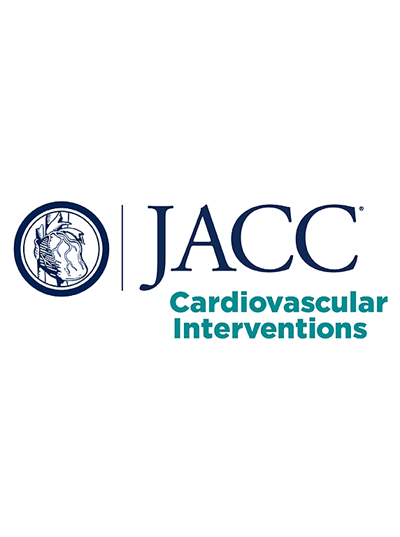Transcatheter Edge-to-Edge Repair for Atrial and Ventricular Secondary Mitral Regurgitation
IF 11.4
1区 医学
Q1 CARDIAC & CARDIOVASCULAR SYSTEMS
引用次数: 0
Abstract
Background
Secondary mitral regurgitation (SMR) has 2 phenotypes: atrial (aSMR) and ventricular (vSMR). The role of mitral valve transcatheter edge-to-edge repair (M-TEER) in aSMR remains less defined, with limited evidence on the PASCAL implant (Edwards Lifesciences).
Objectives
The authors sought to evaluate and compare outcomes of SMR phenotypes undergoing M-TEER.
Methods
REPAIR (REgistry of PAscal for mItral Regurgitation) is an investigator-initiated, multicenter registry of patients undergoing M-TEER. aSMR was defined by left atrial dilation with preserved left ventricular size and ejection fraction. Outcomes included MR ≤1+ at discharge, technical success, NYHA functional class improvement, and 1-year survival.
Results
Among 915 patients (166 [18%] aSMR, 749 [82%] vSMR), the median follow-up was 491 days (Q1-Q3: 360-833 days). MR ≤1+ was achieved in 77.2% vs 71.4% (P = 0.162), with technical success in 97.0% vs 98.3% (P = 0.446). NYHA functional class improved in both phenotypes (P < 0.001), with 61.2% vs 61.3% in functional class ≤II at follow-up (P > 0.999). One-year survival was 88.4% (95% CI: 82.8%-94.4%) vs 86.0% (95% CI: 83.1%-89.0%; P = 0.346). In aSMR patients, 1-year survival was significantly lower in patients with baseline tricuspid regurgitation (TR) grade ≥moderate compared with those with <moderate TR (84.3% [95% CI: 77.0%-92.3%] vs 100.0% [95% CI: 100.0%-100.0%]; P = 0.041). In vSMR patients, survival was similar between ≥moderate and <moderate baseline TR (83.9% [95% CI: 79.8%-88.2%] vs 89.3% [95% CI: 85.0%-93.8%]; P = 0.051).
Conclusions
M-TEER effectively reduces MR to ≤1+ and improves symptoms in both aSMR and vSMR. Particularly in aSMR, ≥moderate baseline TR is linked to worse outcomes, warranting consideration as an additional treatment target.
经导管边缘到边缘修复心房和心室继发性二尖瓣反流:来自修复研究的见解。
背景继发性二尖瓣反流(SMR)有两种表型:心房(aSMR)和心室(vSMR)。二尖瓣经导管边缘到边缘修复(M-TEER)在aSMR中的作用尚未明确,PASCAL植入物的证据有限(Edwards生命科学公司)。目的作者试图评估和比较SMR表型接受M-TEER的结果。方法srepair(二尖瓣反流的PAscal注册)是一项由研究者发起的、多中心的M-TEER患者注册。aSMR的定义是左心房扩张并保留左心室大小和射血分数。结果包括出院时MR≤1+、技术成功、NYHA功能分级改善和1年生存率。结果915例患者(166例[18%]aSMR, 749例[82%]vSMR)中位随访时间为491天(Q1-Q3: 360-833天)。MR≤1+的成功率77.2% vs 71.4% (P = 0.162),技术成功率97.0% vs 98.3% (P = 0.446)。两种表型的NYHA功能分级均有改善(P < 0.001),随访时功能分级≤II的NYHA功能分级分别为61.2%和61.3% (P < 0.999)。一年生存率为88.4% (95% CI: 82.8%-94.4%) vs 86.0% (95% CI: 83.1%-89.0%;P = 0.346)。在aSMR患者中,基线三尖瓣反流(TR)等级≥中度的患者的1年生存率显著低于TR <中度的患者(84.3% [95% CI: 77.0%-92.3%] vs 100.0% [95% CI: 100.0%-100.0%];P = 0.041)。在vSMR患者中,≥中度和<中度基线TR患者的生存率相似(83.9% [95% CI: 79.8%-88.2%] vs 89.3% [95% CI: 85.0%-93.8%];P = 0.051)。结论sm - teer可有效降低aSMR和vSMR的MR至≤1+,改善症状。特别是在aSMR中,≥中等的基线TR与较差的结果相关,值得考虑作为额外的治疗目标。
本文章由计算机程序翻译,如有差异,请以英文原文为准。
求助全文
约1分钟内获得全文
求助全文
来源期刊

JACC. Cardiovascular interventions
CARDIAC & CARDIOVASCULAR SYSTEMS-
CiteScore
11.60
自引率
8.80%
发文量
756
审稿时长
4-8 weeks
期刊介绍:
JACC: Cardiovascular Interventions is a specialist journal launched by the Journal of the American College of Cardiology (JACC). It covers the entire field of interventional cardiovascular medicine, including cardiac, peripheral, and cerebrovascular interventions. The journal publishes studies that will impact the practice of interventional cardiovascular medicine, including clinical trials, experimental studies, and in-depth discussions by respected experts. To enhance visual understanding, the journal is published both in print and electronically, utilizing the latest technologies.
 求助内容:
求助内容: 应助结果提醒方式:
应助结果提醒方式:


